Jiwoo Lee
Conditional Temporal Neural Processes with Covariance Loss
Apr 01, 2025Abstract:We introduce a novel loss function, Covariance Loss, which is conceptually equivalent to conditional neural processes and has a form of regularization so that is applicable to many kinds of neural networks. With the proposed loss, mappings from input variables to target variables are highly affected by dependencies of target variables as well as mean activation and mean dependencies of input and target variables. This nature enables the resulting neural networks to become more robust to noisy observations and recapture missing dependencies from prior information. In order to show the validity of the proposed loss, we conduct extensive sets of experiments on real-world datasets with state-of-the-art models and discuss the benefits and drawbacks of the proposed Covariance Loss.
* 11 pages, 18 figures
Exploring Multimodal Perception in Large Language Models Through Perceptual Strength Ratings
Mar 10, 2025Abstract:This study investigated the multimodal perception of large language models (LLMs), focusing on their ability to capture human-like perceptual strength ratings across sensory modalities. Utilizing perceptual strength ratings as a benchmark, the research compared GPT-3.5, GPT-4, GPT-4o, and GPT-4o-mini, highlighting the influence of multimodal inputs on grounding and linguistic reasoning. While GPT-4 and GPT-4o demonstrated strong alignment with human evaluations and significant advancements over smaller models, qualitative analyses revealed distinct differences in processing patterns, such as multisensory overrating and reliance on loose semantic associations. Despite integrating multimodal capabilities, GPT-4o did not exhibit superior grounding compared to GPT-4, raising questions about their role in improving human-like grounding. These findings underscore how LLMs' reliance on linguistic patterns can both approximate and diverge from human embodied cognition, revealing limitations in replicating sensory experiences.
Recommendations for Comprehensive and Independent Evaluation of Machine Learning-Based Earth System Models
Oct 24, 2024Abstract:Machine learning (ML) is a revolutionary technology with demonstrable applications across multiple disciplines. Within the Earth science community, ML has been most visible for weather forecasting, producing forecasts that rival modern physics-based models. Given the importance of deepening our understanding and improving predictions of the Earth system on all time scales, efforts are now underway to develop forecasting models into Earth-system models (ESMs), capable of representing all components of the coupled Earth system (or their aggregated behavior) and their response to external changes. Modeling the Earth system is a much more difficult problem than weather forecasting, not least because the model must represent the alternate (e.g., future) coupled states of the system for which there are no historical observations. Given that the physical principles that enable predictions about the response of the Earth system are often not explicitly coded in these ML-based models, demonstrating the credibility of ML-based ESMs thus requires us to build evidence of their consistency with the physical system. To this end, this paper puts forward five recommendations to enhance comprehensive, standardized, and independent evaluation of ML-based ESMs to strengthen their credibility and promote their wider use.
Learning from Negative Samples in Generative Biomedical Entity Linking
Aug 29, 2024



Abstract:Generative models have become widely used in biomedical entity linking (BioEL) due to their excellent performance and efficient memory usage. However, these models are usually trained only with positive samples--entities that match the input mention's identifier--and do not explicitly learn from hard negative samples, which are entities that look similar but have different meanings. To address this limitation, we introduce ANGEL (Learning from Negative Samples in Generative Biomedical Entity Linking), the first framework that trains generative BioEL models using negative samples. Specifically, a generative model is initially trained to generate positive samples from the knowledge base for given input entities. Subsequently, both correct and incorrect outputs are gathered from the model's top-k predictions. The model is then updated to prioritize the correct predictions through direct preference optimization. Our models fine-tuned with ANGEL outperform the previous best baseline models by up to an average top-1 accuracy of 1.4% on five benchmarks. When incorporating our framework into pre-training, the performance improvement further increases to 1.7%, demonstrating its effectiveness in both the pre-training and fine-tuning stages. Our code is available at https://github.com/dmis-lab/ANGEL.
LAPIS: Language Model-Augmented Police Investigation System
Jul 31, 2024Abstract:Crime situations are race against time. An AI-assisted criminal investigation system, providing prompt but precise legal counsel is in need for police officers. We introduce LAPIS (Language Model Augmented Police Investigation System), an automated system that assists police officers to perform rational and legal investigative actions. We constructed a finetuning dataset and retrieval knowledgebase specialized in crime investigation legal reasoning task. We extended the dataset's quality by incorporating manual curation efforts done by a group of domain experts. We then finetuned the pretrained weights of a smaller Korean language model to the newly constructed dataset and integrated it with the crime investigation knowledgebase retrieval approach. Experimental results show LAPIS' potential in providing reliable legal guidance for police officers, even better than the proprietary GPT-4 model. Qualitative analysis on the rationales generated by LAPIS demonstrate the model's reasoning ability to leverage the premises and derive legally correct conclusions.
MultiPragEval: Multilingual Pragmatic Evaluation of Large Language Models
Jun 11, 2024Abstract:As the capabilities of LLMs expand, it becomes increasingly important to evaluate them beyond basic knowledge assessment, focusing on higher-level language understanding. This study introduces MultiPragEval, a robust test suite designed for the multilingual pragmatic evaluation of LLMs across English, German, Korean, and Chinese. Comprising 1200 question units categorized according to Grice's Cooperative Principle and its four conversational maxims, MultiPragEval enables an in-depth assessment of LLMs' contextual awareness and their ability to infer implied meanings. Our findings demonstrate that Claude3-Opus significantly outperforms other models in all tested languages, establishing a state-of-the-art in the field. Among open-source models, Solar-10.7B and Qwen1.5-14B emerge as strong competitors. This study not only leads the way in the multilingual evaluation of LLMs in pragmatic inference but also provides valuable insights into the nuanced capabilities necessary for advanced language comprehension in AI systems.
Small Language Models Learn Enhanced Reasoning Skills from Medical Textbooks
Mar 30, 2024Abstract:While recent advancements in commercial large language models (LM) have shown promising results in medical tasks, their closed-source nature poses significant privacy and security concerns, hindering their widespread use in the medical field. Despite efforts to create open-source models, their limited parameters often result in insufficient multi-step reasoning capabilities required for solving complex medical problems. To address this, we introduce Meerkat-7B, a novel medical AI system with 7 billion parameters. Meerkat-7B was trained using our new synthetic dataset consisting of high-quality chain-of-thought reasoning paths sourced from 18 medical textbooks, along with diverse instruction-following datasets. Our system achieved remarkable accuracy across seven medical benchmarks, surpassing GPT-3.5 by 13.1%, as well as outperforming the previous best 7B models such as MediTron-7B and BioMistral-7B by 13.4% and 9.8%, respectively. Notably, it surpassed the passing threshold of the United States Medical Licensing Examination (USMLE) for the first time for a 7B-parameter model. Additionally, our system offered more detailed free-form responses to clinical queries compared to existing 7B and 13B models, approaching the performance level of GPT-3.5. This significantly narrows the performance gap with large LMs, showcasing its effectiveness in addressing complex medical challenges.
Pragmatic Competence Evaluation of Large Language Models for Korean
Mar 19, 2024Abstract:The current evaluation of Large Language Models (LLMs) predominantly relies on benchmarks focusing on their embedded knowledge by testing through multiple-choice questions (MCQs), a format inherently suited for automated evaluation. Our study extends this evaluation to explore LLMs' pragmatic competence--a facet previously underexamined before the advent of sophisticated LLMs, specifically in the context of Korean. We employ two distinct evaluation setups: the conventional MCQ format, adapted for automatic evaluation, and Open-Ended Questions (OEQs), assessed by human experts, to examine LLMs' narrative response capabilities without predefined options. Our findings reveal that GPT-4 excels, scoring 81.11 and 85.69 in the MCQ and OEQ setups, respectively, with HyperCLOVA X, an LLM optimized for Korean, closely following, especially in the OEQ setup, demonstrating a score of 81.56 with a marginal difference of 4.13 points compared to GPT-4. Furthermore, while few-shot learning strategies generally enhance LLM performance, Chain-of-Thought (CoT) prompting introduces a bias toward literal interpretations, hindering accurate pragmatic inference. Considering the growing expectation for LLMs to understand and produce language that aligns with human communicative norms, our findings emphasize the importance for advancing LLMs' abilities to grasp and convey sophisticated meanings beyond mere literal interpretations.
Improving seasonal forecast using probabilistic deep learning
Oct 27, 2020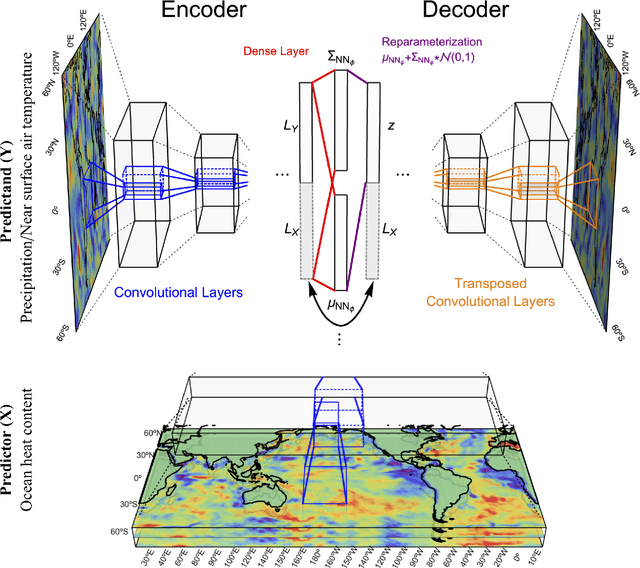
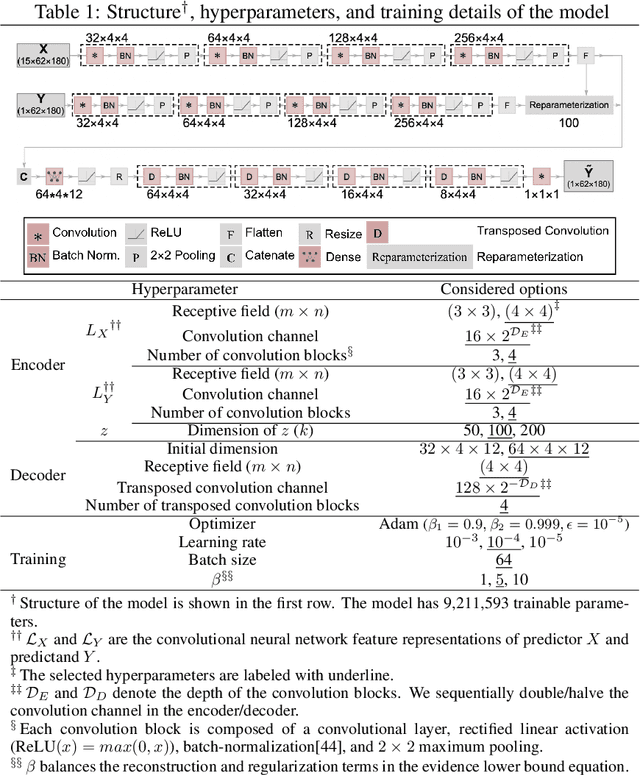
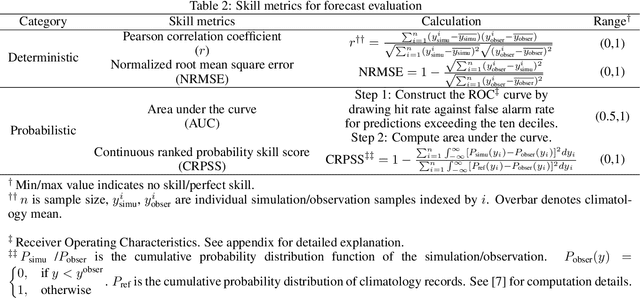
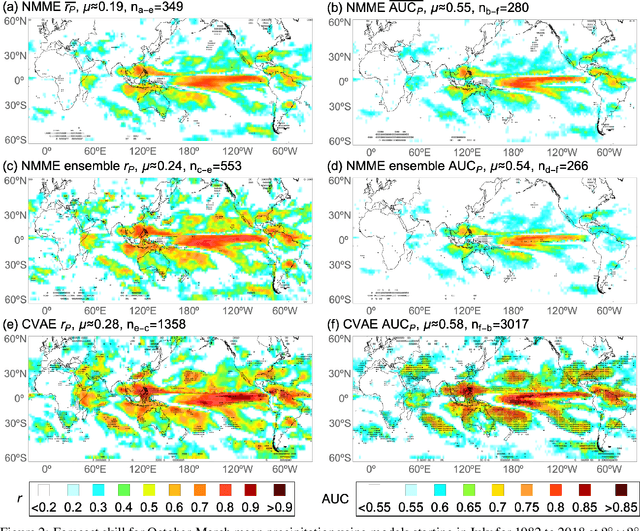
Abstract:The path toward realizing the potential of seasonal forecasting and its socioeconomic benefits depends heavily on improving general circulation model based dynamical forecasting systems. To improve dynamical seasonal forecast, it is crucial to set up forecast benchmarks, and clarify forecast limitations posed by model initialization errors, formulation deficiencies, and internal climate variability. With huge cost in generating large forecast ensembles, and limited observations for forecast verification, the seasonal forecast benchmarking and diagnosing task proves challenging. In this study, we develop a probabilistic deep neural network model, drawing on a wealth of existing climate simulations to enhance seasonal forecast capability and forecast diagnosis. By leveraging complex physical relationships encoded in climate simulations, our probabilistic forecast model demonstrates favorable deterministic and probabilistic skill compared to state-of-the-art dynamical forecast systems in quasi-global seasonal forecast of precipitation and near-surface temperature. We apply this probabilistic forecast methodology to quantify the impacts of initialization errors and model formulation deficiencies in a dynamical seasonal forecasting system. We introduce the saliency analysis approach to efficiently identify the key predictors that influence seasonal variability. Furthermore, by explicitly modeling uncertainty using variational Bayes, we give a more definitive answer to how the El Nino/Southern Oscillation, the dominant mode of seasonal variability, modulates global seasonal predictability.
Deep-dust: Predicting concentrations of fine dust in Seoul using LSTM
Jan 29, 2019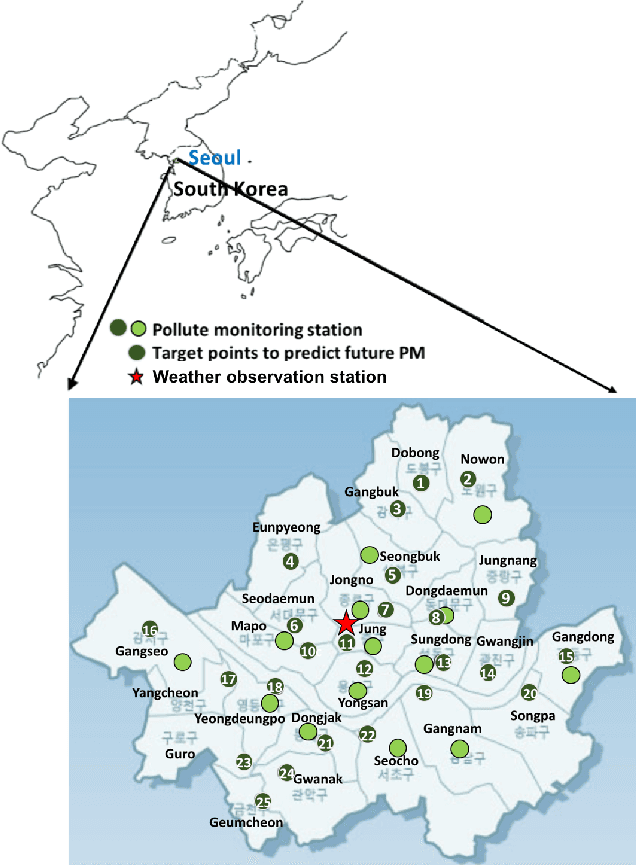
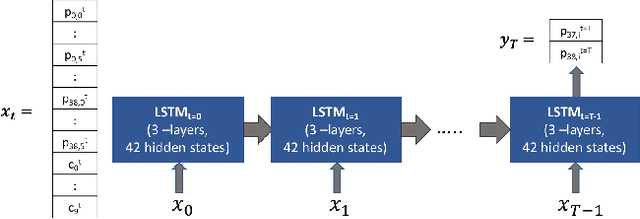


Abstract:Polluting fine dusts in South Korea which are mainly consisted of biomass burning and fugitive dust blown from dust belt is significant problem these days. Predicting concentrations of fine dust particles in Seoul is challenging because they are product of complicate chemical reactions among gaseous pollutants and also influenced by dynamical interactions between pollutants and multiple climate variables. Elaborating state-of-art time series analysis techniques using deep learning, non-linear interactions between multiple variables can be captured and used to predict future dust concentration. In this work, we propose the LSTM based model to predict hourly concentration of fine dust at target location in Seoul based on previous concentration of pollutants, dust concentrations and climate variables in surrounding area. Our results show that proposed model successfully predicts future dust concentrations at 25 target districts(Gu) in Seoul.
* 3 pages, 3 figures, 1 tabel
 Add to Chrome
Add to Chrome Add to Firefox
Add to Firefox Add to Edge
Add to Edge